Comprehensive guide: how to choose the right materials for sauna ceilings
The sauna is the heart of the Finnish home, a place to relax...
Read moreTower/column-mounted electric heaters have been steadily increasing in popularity. Today, around 70% of our customers want a tower stove for their new sauna. In this article, we will discuss how to choose a tower heater, i.e. what things to consider before buying a heater. Choosing the right heater and positioning it correctly in the sauna room is important for the comfort and safety of the sauna.
There are many different manufacturers of pillar chimneys in Finland. We represent IKI-Kiuas Oy and Kajosauna Oy, and in this article we will discuss the installation of five different heater models from these brands. The strokes of a pillar stove are soft and come very close to the strokes offered by wood stoves. The temperature for a perfect sauna experience need not be more than 70-75 degrees!
From left to right: IKI-Kiuas Oy Pilar stove, IKI-Kiuas Oy Monolith stove, Kajo Pilar stove, Kajo Corner and Kajo Wall electric stove.
All heater manufacturers indicate the size of the sauna room for the heater in question, i.e. the minimum and maximum volumes of the room. Each heater model comes in several power sizes. The smallest heaters are 4.5 kW and the largest up to 30 kW, but the most common models range from 6 to 9 kW.
| Stove power | Sauna size | Stove power | Sauna size | Stove power | Sauna size | ||
| 4,5 kW | 3-6 m³ | 9,0 kW | 8-16 m³ | 15,0 kW | 16-26 m³ | ||
| 6,0 kW | 5-9 m³ | 10,5 kW | 10-18 m³ | 18,0 kW | 18-28 m³ | ||
| 7,5 kW | 7-12 m³ | 12,0 kW | 14-24 m³ | 24,0 kW | 22-36 m³ | ||
| 8,0 kW | 7-13 m³ | 13,8 kW | 15-25 m³ | 30 kW | 26-44 m³ |
When the sauna is panelled all around the heater selection is effortless. Calculate the volume of the sauna and choose the right heater. A good “rule of thumb” is that you should preferably choose a heater that is one degree more efficient if the volume of the sauna is close to the upper limit of the chosen model.
For example, my sauna has a volume of 12 m³, is a 7.5 kW heater enough or should I get a more powerful one?
Glass and stone surfaces in walls increase heating times. These uninsulated surfaces increase the actual cubic volume of the sauna. With this formula, you can ensure that the heater is efficient enough: every square metre of uninsulated (glass or stone) surfaces adds one cubic metre to the actual volume of the sauna!
For example, the size of the sauna is 2,5m*2,0m and the height is 2,3m. The sauna has a glass wall and tiles on the door wall, covering the entire wall area.
Without a glass wall, a 7.5-8.0 kW heater would be sufficient, but with a glass wall the heater should have at least 10.5 kW.
Before choosing the location of the heater in the sauna room, you must first place the door in the right place. The heater must be in the right position in relation to the door for safety reasons. Most accidents in the sauna occur with a ladder, therefore compromises between the position of the heater and the door should be avoided. Secondly, the heater should be positioned so that it is easy to use and easy to throw the stove.
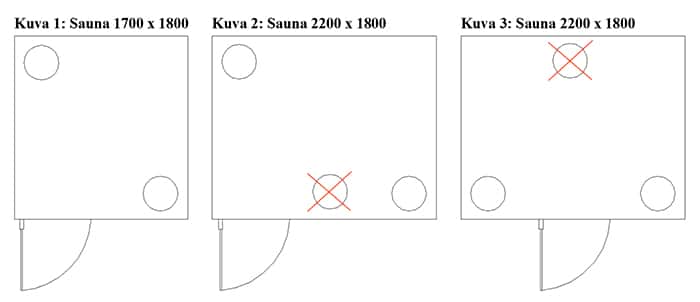
Here are some examples of door and stove locations:
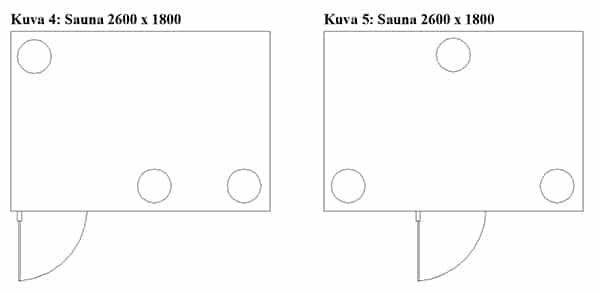
With the design software, you can try out which board options you get when you move the door and the stove.
Tower chimneys can also be integrated, i.e. “embedded” through the footprint. Pillar/tower stoves usually have small fire protection distances. Usually, when a stove is embedded through the skirting, an RST or glass collar is installed around the stove’s embedment opening, the collar “lying” on top of the skirting. Each stove has its own collar, you can order one with the stove.
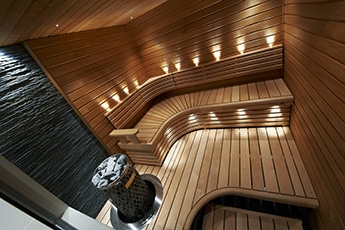
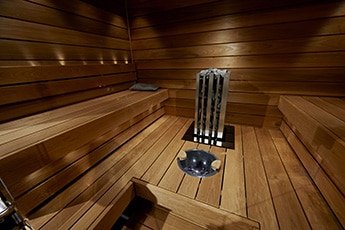
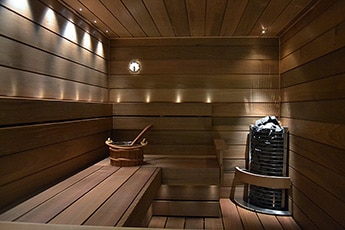

Top left: IKI-Kiuas Oy 7,5 kW, top right: IKI-Kiuas Oy 9 kW Monolith, bottom left: Kajo Corner 6 kW and Kajo Wall 6 kW right
Some space is required for fitting the stove. If the available space allows it, a circular stove is often the first choice. Round 6 kW heaters require a total space of 550-600 mm, while a 7.5-12 kW heater requires 650-700 mm. Kajo’s Corner and Wall models, for example, require only 400-500 mm of space in the depth direction, which is why they are often used in saunas that are so small in the depth direction that it is not possible/reasonable to place a round heater.
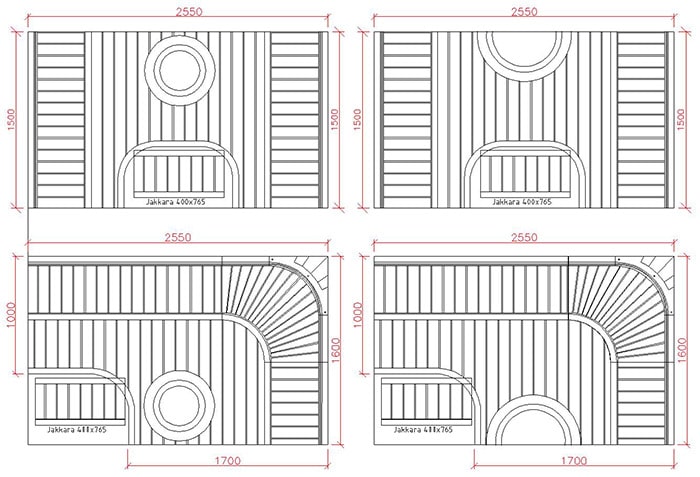
Wall heater: the top view features contrasting ceilings and a large L-shaped laude. The width of the spaces is suitable for the chosen louver model, but the depth is too small for a round pillar stove. In the opposite lutes, the circular stove is almost immediately after the access opening, and in the L lute it is too close to the access passage. A better solution in both cases is the Kajo Wall stove, which is 540 mm wide but only 300 mm deep. Kajo Wall electric heaters can be installed directly against the panel wall of the sauna. The protective distance from the front edge of the heater to the ceiling is only 100 mm.
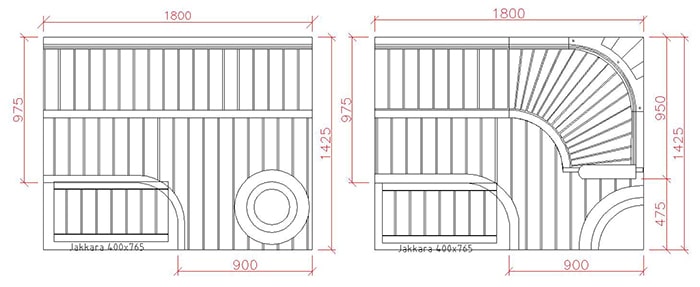
Corner stove: Above is a sauna with dimensions 1800*1425 mm. With a round pillar heater, an L-shaped lude is not possible, as a 6 kW pillar heater requires a space of about 550 mm between the outer edge of the armrest and the surface of the door wall. With a Kajo Corner 6 kW stove, a corner stove is possible. The corner stove can be installed directly against the panel wall and therefore requires less space than the circular model. This gives room for creative design of the ceiling solutions: the Corner heater has a radius of only 300 mm and a safety distance from the front edge of the heater to the ceiling of 100 mm.
When planning your sauna with a pillar heater, try using a Kajon Corner or Wall model heater in a tight situation. The right choice of heater can solve even the most difficult design problems!
Both fixed and stand-alone control centres are available for pillar hooks. Stove models with a separate control centre often also have a separate power unit (the light square section in the right-hand picture). The control centre allows you to switch the heater on and off and to adjust the temperature to the appropriate level. Particularly when the heater is embedded in a pedestal bath, it is advisable to purchase a heater with a separate control unit rather than a fixed control unit. Control panels have a digital display that shows the set temperature, and for aesthetic reasons they often have an oval or rectangular wooden backplate behind them.
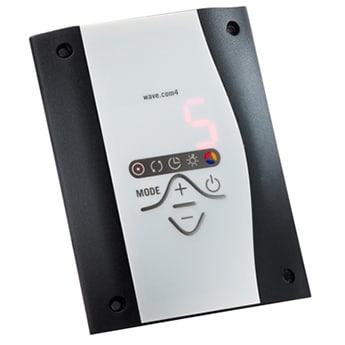
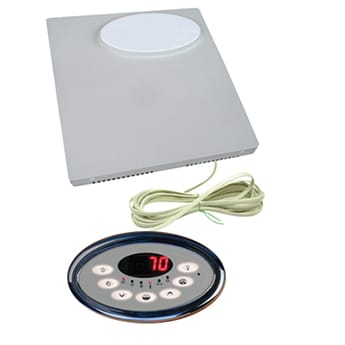
IKI-Kiuas Oy’s and Kajosauna Oy’s stoves use the Wave control centre (left) or the Classic control centre. The Wave control panel can be installed directly inside the sauna room, while the Classic model’s power unit and control panel must be installed in a dry area. This often creates a problem for the renovator in particular when it comes to the electrical design. The Wave control panel has a 5-year warranty for domestic use and a 2-year warranty for professional use.
There is also a version of the Classici model where the power unit is integrated into the lower part of the stove, called i-Classic.
In a heater with a fixed control centre, the switch and heat control knobs are attached to the heater. The fixed control panel is a good choice if the heater is not integrated into a foot bath, and is cheaper than a heater with a separate control panel. If the renovation does not involve replacing the sauna panels but is a smaller-scale renovation, such as replacing a simple ceiling, a heater with a fixed control is a suitable option.